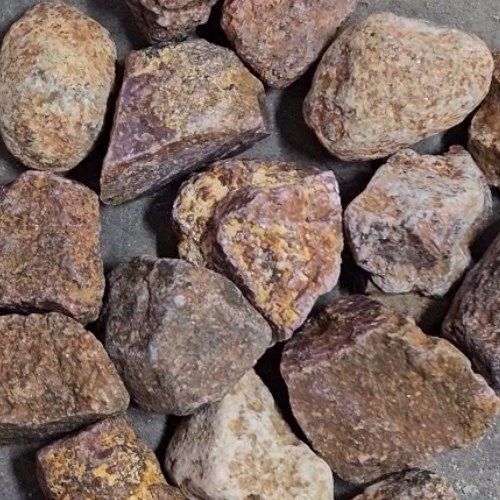Product Description
Ruby Corundum Rough Stone - Select Size
Mineral Information:
Ruby is a precious gemstone known for its rich red color. It is a variety of the mineral corundum, which is composed of aluminum oxide with traces of chromium that give ruby its characteristic hue. Ruby is one of the most highly valued gemstones, prized for its beauty, rarity, and symbolism.
Here are some key features of ruby:
-
Color: Ruby is known for its intense red color, ranging from deep red to slightly purplish or orangish-red hues. The most desirable shade is often referred to as "pigeon blood" red, characterized by a vivid and saturated red color.
-
Hardness: Ruby is one of the hardest gemstones, with a rating of 9 on the Mohs scale of mineral hardness. This makes it highly durable and suitable for everyday wear in jewelry.
-
Brilliance: Ruby has excellent luster and exhibits a captivating glow. When cut and polished, it can display a vibrant and fiery brilliance.
-
Origin: Ruby deposits can be found in various parts of the world, including Myanmar (formerly Burma), Thailand, Sri Lanka, Madagascar, Tanzania, and Afghanistan. Each locality may produce rubies with unique characteristics and color variations.
- Ruby is primarily used in jewelry, including rings, necklaces, earrings, and bracelets. It is often faceted to enhance its brilliance and set in precious metals like gold or platinum. Large, high-quality rubies are particularly valuable and sought after by collectors and connoisseurs.
Metaphysical Meaning:
Ruby is often associated with passion, love, and romance. It is believed to stimulate the heart chakra and enhance feelings of love, intimacy, and desire. It is thought to open the heart to giving and receiving love, promoting emotional well-being and deepening relationships. Ruby is also associated with strength and courage, both physical and emotional. It is believed to empower the wearer to face challenges, overcome obstacles, and take decisive action. It is thought to promote confidence, assertiveness, and resilience in times of adversity.
Mineral Care:
Ruby is considered a relatively durable gemstone with good hardness, but it is not immune to damage or breakage. While it is less fragile than some other gemstones, it still requires proper care to maintain its beauty and integrity. Here are some factors regarding the fragility of ruby:
-
Hardness: Ruby is one of the hardest gemstones, scoring 9 on the Mohs scale of mineral hardness. This high hardness means that it is resistant to scratching and abrasion, making it suitable for everyday wear in jewelry.
-
Toughness: Although ruby is hard, it is not as tough as some other gemstones. Toughness refers to a gemstone's resistance to breaking or chipping under impact. Ruby can withstand normal wear and handling, but it can still be damaged if subjected to hard blows or sharp impacts.
-
Inclusions: Natural rubies often contain inclusions, which are internal features such as tiny cracks, fractures, or mineral inclusions. These inclusions can weaken the overall structure of the stone and make it more susceptible to damage or breakage, especially if they are located in areas of stress or impact.
-
Cleavage: Ruby has no true cleavage, which means it does not naturally split along specific planes like some minerals do. However, it can still break or chip if subjected to significant force or pressure in certain directions.
To protect the fragility of ruby:
-
Setting and Mounting: When using ruby in jewelry, it is important to ensure that it is securely set in a well-designed and properly constructed mounting. This helps protect the gemstone from accidental impacts or dislodgment.
-
Avoiding Impact: To minimize the risk of damage, avoid wearing ruby jewelry during activities that involve heavy physical work, sports, or situations where the gemstone may be exposed to hard blows or rough handling.
-
Cleaning and Storage: Clean ruby jewelry gently using mild soapy water and a soft brush or cloth. Avoid using harsh chemicals or abrasive cleaners that may affect the gemstone's surface. Store ruby jewelry separately in a soft pouch or jewelry box to prevent scratching or contact with other gemstones or hard objects.
-
Professional Maintenance: Periodically have your ruby jewelry inspected by a professional jeweler. They can check for loose settings, signs of wear, or any damage that may require repair or adjustment.
With proper care and maintenance, ruby can be enjoyed for a lifetime. However, it is important to remember that even durable gemstones can still be vulnerable to breakage under extreme circumstances, so it is wise to handle them with care and seek professional advice when needed.
Disclaimer:
No information here is intended to diagnose, treat or cure ailments or afflictions of any kind. One should always consult a medical professional if a serious issue presents itself.








